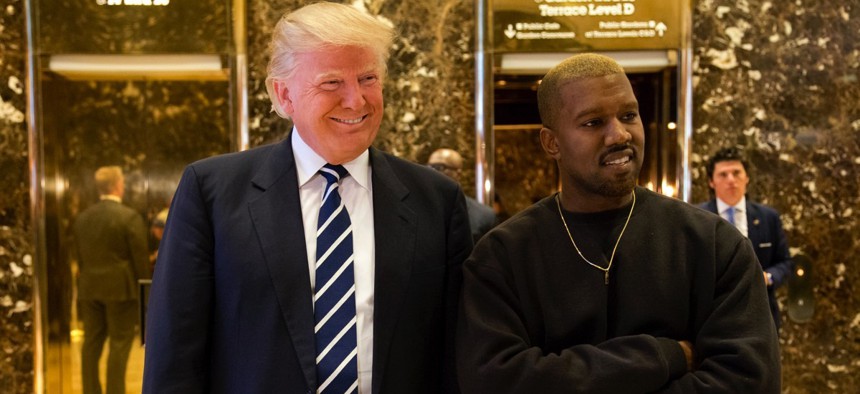Trump’s Infrastructure Ambitions Could Be a Boon for Slow SLED Purchasing

President-elect Donald Trump, left, and Kanye West pose for a picture in the lobby of Trump Tower in New York, Tuesday, Dec. 13, 2016. Seth Wenig / AP Photo

Connecting state and local government leaders
But any new policies will take several quarters to reverberate in state and local agencies’ procurement.
State and local government purchasing should continue at its slow average pace in 2017, free from economic disruption and with upside potential should new infrastructure projects begin, according to a new Onvia report.
The Seattle-based commerce intelligence company’s “2017 State & Local Government Contracting Forecast” labels 2017 a transition year, where the effects of new economic, tax, regulatory and fiscal policies will be felt late.
In November, more than $200 billion in transportation funding initiatives were approved across 25 states for the next decade, and that’s expected to increase under President-elect Trump’s proposal to spend $1 trillion on infrastructure, additional public-private partnerships and possible federal stimulus money.
“The new administration hasn’t, at least publicly, fleshed out its plans in a very detailed way. However, it has made it abundantly clear that it wants the private sector to play a significant role,” writes Dan White, Moody’s Analytics senior economist, in the report. “Those governments who best understand how to take advantage of P3s will be ahead of the curve once a bill is put into place.”

State tax revenue growth continues to decline as spending on worker benefits and Medicaid mounts, White adds, but states will be granted more flexibility to implement their Medicaid programs in light of less federal assistance.
More state, local and education agencies, often referred to as the SLED market, view IT as an investment rather than a routing expense, which coupled with ongoing cybersecurity concerns make the area ripe for continued growth, according to the report. Since 2010, annual IT spending has risen from $29 billion to $34 billion—a 17 percent increase.
“More and more government buyers will be asked to articulate and defend the cyber security posture of new IT purchases, often requiring alignment with federal, state, or government-specific standards,” writes Ben Vaught, Onvia Exchange director. “More governments will ask for—and receive in greater frequency—funds to replace old and vulnerable systems under the guise of cybersecurity concerns.”
While there’s a great deal of uncertainty surrounding the incoming Trump administration’s policy intentions and potential impacts, the report predicts a cyclical small improvement in the bid volume growth rate in 2017 past zero.

The full report can be read here.
Dave Nyczepir is a News Editor at Government Executive’s Route Fifty and is based in Washington D.C.

NEXT STORY: How FEMA Identified Its Mission and Consolidated





